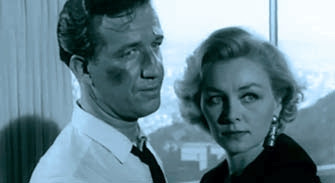There
is a 99.99% chance you will not recognize anyone in this very late-to-the-party film noir offering. A
cast of total unknowns with more television credits than films.
Davis-Wilson Productions (Wilson, as in Doug Wilson) will also be
unknown as well as Sterling World Distributors. Not a problem. Though obviously lean on production values, the leads, especially Wilson, do not embarrass themselves
and the dialogue is also lean with some snappy lines. This film is Wilson's baby, a self-produced film lending freedom without studio bigwigs butting in. At about an hour long, this is a decent (albeit 1950s) film proving that low budgets can do
wonders in the right hands. Few movies have a more appropriate title than
this one. Everyone wants Wilson outta town. Even his mother.
Nothing
like a jazz score and a good beatin’ in the dark to get your
attention over the opening credits. With every punch, there is a trumpet
blast. All that is missing are the superimposed graphic words, “Pow!”
or “Blat!” Wilson’s face is a cross between an older Tim Allen
and a younger Richard Boone. He walks like an ordinary guy, at times
lazily tilting back and forth, side to side as if one leg is
slightly shorter. He does a fine job here and might have made a good
Philip Marlowe. Yet this was his last film after only a few roles to
his name. This "been-there-done-that" film hardly disappoints from an entertainment perspective, especially the scenes that may
make your shoulders bounce up and down with laughter.

Told
with a brief flashback, we find Wilson wondering what led up to his
vicious, opening attack. He is back in Los Angeles to bury his crime-punk brother. He first encounters a disgruntled police officer, the premature balding, Frank
Hardy, whose facial expression gives a distinct impression smiling was never his thing. He hates the sight
of Wilson and tells him to get outta town as quickly as possible.
Wilson tries to explain that his three years in prison changed
him though he quickly realizes it is futile to continue flappin' his
lips. Niceties are not exchanged. Hardy does not trust the former
hoodlum. As Wilson moves on, he confirms to his partner that Wilson
is “As rough as a stucco bathtub.” A great line
and point taken.

Wilson pays a visit to his former girlfriend, Jeanne Braid, (above top) who does not
believe in his transformation. She wants him outta town. Braid lets
it slip his brother was probably murdered. Wilson sets out to avenge
his brother's death one door at a time. When he is not knocking on
doors he is leaving a building, pausing to light a cigarette, and thinking about which direction to go next. This repeats a few times and its
frequency is amusing, like scenes that might precede
a television commercial break.
Wilson
reconnects with “Squirrel,” a nervous stoolie for a local gang.
He is thrilled to see Wilson again but you get the feeling “Squirrel”
might rat on him just to keep in good with his boss. He takes Wilson
out back to a secret door, loosely painted with a huge black,
“X.” How the cops have missed this is amazing. Looks like an
“Our Gang” clubhouse entrance. He reunites with an old pal who is
also surprised to see Wilson. With another noir quip, he tells Wilson
he had him figured for a “concrete kimona.” In the ranks is a guy
who does not like Wilson simply because he does not know him. Even he
is unfamiliar with the cast. He tries to remove Wilson with a screwdriver. Perhaps a Phillips-head. Wilson throttles the kid with the
butt end of a loaded steel beer can then a fist
to silence him. “Squirrel” goes nuts. Wilson is back!
After
the flashback has expired, there are plenty of doors left to knock on
as he reunites with Lee Kross and his wife, played by the blonde Marilyn
O'Connor. She and Wilson have a past and he accepts her advances to
find out the whole truth about Kross. He agrees to help Wilson find
out about his brother but first, oddly, he says he needs to change
his shirt. What he had on looked perfectly acceptable to me. The
ending wraps up very suddenly, with rapid-fire verbal exchanges
between Wilson and Kross informing the viewer of the latter's
backstory. He turns into a sniveling coward when reminded of his slim
chance of surviving the syndicate. The police arrive to find Kross
attempting to make a run for it. Hardy is not pleased that Wilson is
still in town.
For
the final time, with saxophone in support, Wilson exits a building,
pauses, then decides to go right. By now, Braid has come to terms
with his life's turnaround and she rushes to join him in San Francisco.
















